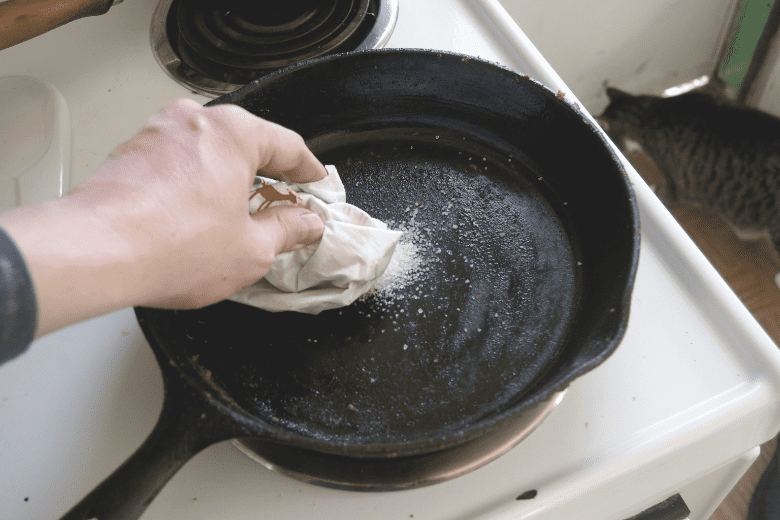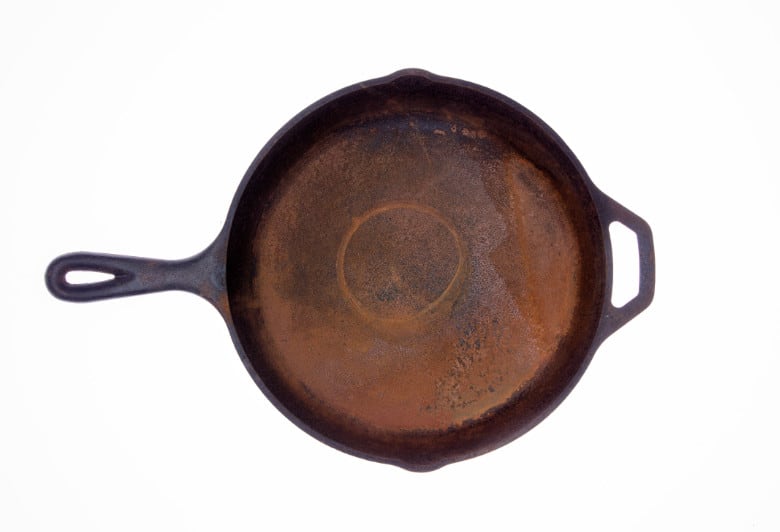I love my cast iron cookware because it’s practically indestructible, retains heat like nothing else, and is the skillet of choice for my “world-famous” jalapeno cornbread. And, if it’s seasoned properly, offers a remarkable chemical-free, nonstick surface.
But, cast iron requires special care to keep its nonstick coating intact, and prevent rust formation.
Continue reading to discover how to clean cast iron skillets, dutch ovens, or grills to keep them in premium condition for many years or even a lifetime.
Related: Our Cookware Buying Guide. How To Find Your Perfect Set.
How to Clean Cast Iron In 3 Steps
Let’s break down in 3 steps how to take care of your cast iron skillet to keep it in perfect condition. Cast iron is a strong material that’s very difficult to break, so, more often than not, the reason people have to replace their cast iron cookware is due to poor care.
What You’ll Need
- Dishwasher soap
- Soft brush or sponge (such as Scotch-Brite or Scrub Daddy)
- Kosher salt (optional)
- Soft cloth or paper towels
- Unsaturated cooking oil (vegetable or canola for a high smoke point)
Step 1: Clean
- Scrape away any food from the surface using a wooden spoon or sponge.
- Rinse the skillet under the tap to remove any remaining food.
- Use a soft brush (one that’s not too abrasive) to wipe away any stuck-on food, using hot water to assist you. Apply circular motions to avoid scrubbing an area too firmly. Too much force can begin to remove the seasoning.
- For stubborn food, apply hot, soapy water to the skillet, using your brush to focus on stains. Pay attention around the handle, too, as food and sauces can accumulate there as well.
- Rinse.

For Stubborn Messes
- If you’ve scorched food into the pan, and the above method isn’t successful, pour kosher salt onto the area. This works to carbonize food particles, making it easier to remove.
- Place the skillet over high heat, and remove from the heat.
- Use gentle circular motions with a soft cloth to use the salt as an exfoliator on the tough stains. Don’t be afraid of applying a bit of elbow grease, if necessary.
- Rinse the skillet under warm water.
- Wipe and dry the area with a paper towel.
- If this fails, you can always add boiling water to the pan, and allow it to simmer for 10 minutes before removing it from the heat and then rinsing and drying it.

Step 2: Dry
Compared to other kitchen materials, cast iron requires effective, responsive drying time to prevent rust. Water is cast iron’s enemy, so always dry the skillet after every clean.
- Ensure no dishwasher soap is on the surface, and rinse until the water is clear.
- Allow the skillet to drain for several minutes.
- Use a lint-free, microfiber cloth or a paper towel to wipe away residue. You may notice some black marks, which are usually just seasoning from the pan and nothing to worry about (although this can be an indication that it needs re-seasoning).
Alternative Drying Method
This method is a quick, gentle alternative to drying your skillet by hand, and it protects the nonstick coating, helping the seasoning to last longer. Heat speeds up evaporation and ensures the pan is completely dry.
- Drain the skillet to allow most of the water to rinse off.
- Place the skillet over a low flame, and allow it to sit for five minutes until there are no more water particles, or place the pan in a heated oven until dry.
Step 3: Oil
The final step to caring for your cast iron pan is to add a layer of protective seasoning before you put it away. This step helps to form a nonstick layer, so food doesn’t accumulate on the pan, and you don’t require as much oil/butter when cooking.
- Lightly rub the pan with your chosen vegetable oil, ensuring that you don’t apply too thick of a coat that it looks greasy. Apply the oil to the skillet and use your fingers, a delicate brush, or a soft paper towel to distribute it evenly.
- Place the skillet over high heat for a few minutes so the pan is heated evenly, and it begins to smoke slightly. (Alternatively, place the pan in the oven for an hour for even heating, but be careful with the hot handle when you remove it).
Related: How Seasoning Cast Iron Is The Secret To Great Cooking
Conclusion
Many home cooks tend to shy away from using cast iron cookware fearing it requires too much maintenance. In reality, it really is so simple. I absolutely love my cast iron pans.
FAQs
How do you restore a rusty cast iron skillet?
Prevention is better than cure, so avoid submerging a cast iron skillet in water and never wash it in the dishwasher. Use steel wool to remove rust from the affected areas, using different amounts of pressure depending on the severity. You don’t need to worry about being too rough because the main reason you’re gentle with cast iron is not to strip away the seasoning, which will already have happened if rust is present.

How often should you clean cast iron?
Thoroughly clean and wipe down your cast iron pans after every use to remove a buildup of food and bacteria on the surface. Additionally, a well-seasoned pan can hold its nonstick coating for years, but we recommend seasoning your cookware twice a year. Use your discretion with this frequency if you notice the surface becomes progressively stickier when you’re cooking.
Can I soak my cast iron pan?
Avoid this at all costs! Some people think that soaking your cast iron pan helps to soften food stuck onto the surface. But cast iron is porous, which means long water exposure will result in rust. A short soak for a couple of minutes might not have this effect, but it’s not worth taking the chance.
Can I use soap to wash cast iron?
Yes, but consider a mild one because a brand with harsh chemicals can strip away the seasoning. You’ll only need a small amount of soap when washing your skillet regularly.
Can I use steel wool to clean cast iron?
Steel wool can strip the seasoning layer, resulting in food sticking to the surface. Steel wool is too abrasive for daily cleaning, but it removes rust effectively. Stick to a softer sponge to gently buff away food. Also, regularly stir food when cooking to prevent it from sticking to the pan.
Is cast iron dishwasher safe?
No. A dishwasher is too abrasive on cast iron pans and will remove the seasoning, making food stick to it. Dishwashers also soak the pan, which can lead to rust. You should dry a cast iron skillet as soon as it’s washed (plus dishwashers are humid).
